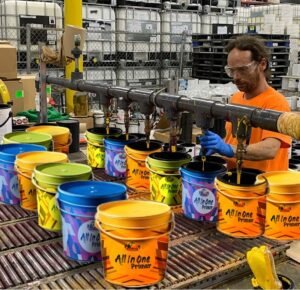Introduction to the Paint Production Industry
paint production business plan
The paint production industry plays a crucial role in the global economy, spanning various sectors, including construction, automotive, and manufacturing. As the demand for paints and coatings continues to grow, driven by an increase in infrastructure development and consumer spending, it is vital for entrepreneurs to understand the current state of this industry. According to recent market analyses, the global paint market is projected to exhibit significant growth over the next few years, providing ample opportunities for new entrants.
One of the prominent trends within the industry is the rising preference for environmentally friendly and sustainable products. Consumers are increasingly seeking mithla home paints and other eco-friendly options, which has prompted manufacturers to innovate and adapt their product lines accordingly. The shift toward water-based paints and low-VOC (Volatile Organic Compounds) formulations not only meets consumer demands but also aligns with global sustainability goals. Furthermore, advancements in technology, such as digital color matching and automated mixing techniques, are revolutionizing production processes and enhancing overall efficiency.
Understanding the competition, consumer preferences, and regulatory landscapes is essential for any entrepreneur looking to establish a foothold in the paint production sector. The diverse range of products, including interior and exterior paints, specialty coatings, and industrial finishes, creates various niches within the market. Additionally, the growth of the DIY (Do-It-Yourself) segment has led to an increased demand for consumer-grade paints, making it imperative for businesses to offer high-quality options. A solid business plan that addresses these industry dynamics will not only help potential entrepreneurs navigate the complexities of this sector but also set a foundation for successful operations in the competitive landscape of paint production.

Defining Your Business Objectives
Establishing clear business objectives is a fundamental step for any paint production company, including those engaged in the manufacturing of mithla home paints. Effective objectives guide decision-making and provide a roadmap for measuring progress. They can be categorized into short-term and long-term goals, each playing a vital role in steering the company towards success.
Short-term goals typically focus on immediate outcomes that can be achieved within a year. For a paint production business, these may include launching a new line of paints, increasing sales by a certain percentage, or improving production efficiency. By setting attainable short-term objectives, companies can create a solid foundation for operational success while fostering team motivation through achievable milestones. These immediate targets should align with market demands, thereby ensuring that product offerings, such as mithla home paints, meet customer needs effectively.
Long-term goals, on the other hand, span a period that exceeds one year and involve broader aspirations such as expanding market reach, enhancing brand reputation, or innovating product lines. For paint manufacturers, these objectives may encompass developing sustainable practices, exploring international markets, or achieving a specified market share within the home paints sector. Long-term objectives should be carefully crafted to align with industry trends and consumer preferences, ensuring that the company remains competitive and relevant.
In conclusion, the process of defining business objectives in the paint production realm is indispensable. To succeed, companies must strike a delicate balance between short-term and long-term goals, ensuring that each objective is aligned with current market demands. A well-structured approach to goal setting will not only guide daily operations but will also serve as a foundation for a robust business plan, ultimately enhancing the chances of long-term viability in the competitive landscape of mithla home paints and beyond.
Market Research and Analysis
Conducting in-depth market research and analysis is pivotal for establishing a successful paint production business, particularly when focusing on products like Mithla home paints. Understanding your target customers involves identifying their preferences, buying behavior, and the specific needs they have regarding paint products. Utilizing various research methodologies such as surveys and focus groups can provide significant insights into consumer trends and attitudes towards home paint options. Surveys can be distributed online or in person, while focus groups offer a platform for more interactive discussions regarding brand perceptions and product requirements.
Moreover, analyzing the competitive landscape is essential. This involves examining competitors who offer similar solutions, such as other home paint manufacturers. A comprehensive competitor analysis should include their product ranges, marketing strategies, pricing, and customer satisfaction levels. By understanding what your competitors are doing well, as well as where they may be lacking, you can carve out a unique position in the market for your Mithla home paints. This can inform decisions about product differentiation and how you can better meet customer expectations.
Additionally, identifying potential challenges and market trends forms an integral part of your analysis. The paint industry, including niche areas like Mithla home paints, is influenced by several factors including economic conditions, regulatory changes, and consumer shifts towards sustainable products. Keeping abreast of these trends ensures that your business is agile and capable of adapting to changing demands in the market. Utilizing tools like SWOT analysis (Strengths, Weaknesses, Opportunities, Threats) can further aid in mapping out both external market challenges and internal capabilities. Ultimately, thorough market research not only helps to inform your business plan but also sets a strategic foundation for sustainable growth within the competitive paint industry.

Product Development and Production Strategy
Developing a comprehensive product development and production strategy is crucial for establishing a successful paint production business, such as mithla home paints. The first step involves formulating paint products that meet market demands while ensuring quality and performance. This process typically encompasses selecting appropriate base materials, pigments, and additives to achieve desired properties such as durability, finish, and safety. Engaging qualified chemists or formulators can help streamline this phase and facilitate compliance with industry standards.
Quality control is another vital component of the product development process. Implementing stringent testing protocols throughout the formulation and production phases ensures that every batch of paint meets safety regulations and performance specifications. This may include laboratory testing for viscosity, color consistency, adhesion, and drying time, among other quality parameters. Such thorough quality assurance measures enhance consumer trust and satisfaction, ultimately positioning mithla home paints as a reliable choice in the market.
When it comes to production methods, selecting the right equipment is essential. Depending on the scale of production, businesses may opt for batch processing or continuous production systems. Each method has its advantages; batch processing allows for flexibility in product formulations, while continuous production ensures efficiency and consistency in output. Additionally, sourcing raw materials from reliable suppliers plays a critical role in maintaining product quality and availability. Establishing strong relationships with vendors can facilitate better procurement practices, ensuring that necessary materials are always on hand.
Finally, developing a realistic production timeline encapsulates the various stages of product development and manufacturing, from formulation to launch. By assessing each step of the process, businesses can create a coherent blueprint that aligns production capabilities with market entry strategies, ultimately paving the way for a successful launch of mithla home paints in the competitive landscape.

Marketing and Sales Plan
Developing a robust marketing and sales plan is integral to the success of a paint production business. The first step is establishing a strong brand identity for your products, such as mithla home paints. A clearly defined brand that resonates with your target audience can differentiate your offerings in a crowded marketplace. Consider creating a memorable logo, a compelling brand story, and choosing color schemes that reflect the quality and versatility of your paints.
Pricing strategies are another essential aspect. Conducting market research will help you identify competitive pricing while ensuring profitability. Consider the cost of production, market demand, and the pricing of competitors’ products. Offering varied price points can also attract different customer segments—from budget-conscious consumers to those seeking premium quality, such as luxury mithla home paints.
Promotional activities should encompass both online and offline channels. Social media platforms can serve as effective tools for engaging potential customers and showcasing the unique features and benefits of your paints. Additionally, hosting workshops or demonstrations can create hands-on experiences that draw customers in and demonstrate the application of your products. Collaborations with influencers in the home improvement niche can further amplify your reach.
Distribution channels play a crucial role as well. Establishing partnerships with retailers and contractors can increase accessibility to your paints. Consider direct sales through your website, among other avenues, to efficiently reach customers. Building strong relationships with distributors and retailers fosters trust and encourages them to promote your brand actively. Engage in consistent communication and support their sales efforts through marketing materials and promotions that emphasize mithla home paints.
In conclusion, a well-crafted marketing and sales plan that focuses on branding, strategic pricing, promotional activities, and robust distribution channels is vital for the success of your paint production business. By executing these strategies effectively, your business can thrive in the competitive landscape of the paint industry.

Financial Projections and Budgeting
Creating a comprehensive financial projection and budgeting plan is crucial for the success of a paint production business, such as one focusing on mithla home paints. Understanding the financial landscape will not only help clarify startup costs but also facilitate ongoing operational management. The initial phase involves identifying and aggregating all startup costs associated with the business. These may include expenses related to equipment acquisition, initial inventory of raw materials, lease agreements for production space, and marketing initiatives to establish brand presence. Properly forecasting these expenses allows entrepreneurs to gauge the required capital investment before commencing operations.
Once startup costs are identified, a thorough analysis of operating expenses becomes essential. This encompasses recurring costs such as raw material procurement for producing mithla home paints, employee salaries, utilities, and maintenance costs. By keeping a detailed record of these ongoing expenses, entrepreneurs can better manage cash flow and ensure that their operations remain solvent.
In addition to these elements, performing a break-even analysis is vital. This technique calculates the point at which total revenues equal total costs, allowing entrepreneurs to determine how much product they need to sell to cover their expenses. For businesses specializing in home paints, understanding the number of units required to break even provides insights into pricing strategies and inventory management.
Finally, revenue forecasts should be meticulously crafted to project future sales. This assists in setting realistic goals based on market analysis and historical data if available. Assessing potential market demand for mithla home paints enables business owners to develop achievable revenue targets, facilitating strategic planning and resource allocation. By combining startup costs, operating expenses, break-even analysis, and revenue forecasts, entrepreneurs are better equipped to develop a sound financial strategy that supports their paint production business.
Regulatory and Environmental Considerations
Establishing a successful paint production business necessitates a comprehensive understanding of the regulatory and environmental landscape. Compliance with health and safety regulations is paramount to ensure not only the safety of employees but also the quality of products such as mithla home paints. These regulations often encompass workplace safety measures, proper handling of hazardous materials, and the implementation of protective equipment protocols. Adhering to these guidelines can significantly mitigate the risk of accidents that could pose threats to both employees and the surrounding community.
In addition to workplace safety, environmental laws play a crucial role in paint production. The use of certain chemicals in manufacturing paints, including those used in mithla home paints, may be subject to strict regulations under the Environmental Protection Agency (EPA) and similar authorities. These regulations might dictate the emissions and waste management practices that businesses must adopt in order to minimize their environmental footprint. For instance, the necessity for utilizing water-based solutions over solvent-based formulations can not only lead to compliance but also appeal to a growing market that prioritizes eco-friendly products.
To operate effectively within this regulatory framework, businesses must obtain various permits and certifications. These may include environmental permits that allow for the discharge of materials or emissions and health and safety certifications that demonstrate adherence to industry standards. It is advisable for paint manufacturers to consult with legal professionals who specialize in environmental and occupational safety law to navigate this complex terrain. By ensuring full compliance with all necessary regulations and standards, companies can safeguard themselves from legal repercussions while enhancing their reputation among consumers who seek responsible brands in the paint industry.
Operational Plan and Management Structure
The operational plan for a paint production business, such as those producing mithla home paints, serves as a blueprint for daily activities and ensuring efficient functioning. An integral part of this plan is the organizational structure, which outlines the various roles within the company. Typically, a paint production business requires a manager, production team, quality assurance personnel, sales and marketing representatives, and administrative staff. Each role contributes significantly to the overall workflow and effectiveness of the organization.
Staffing needs should be carefully assessed to ensure that there is an optimal number of employees for all operational areas. For example, a production line dedicated to mithla home paints may require skilled workers to operate machinery and mix raw materials accurately. Additionally, positions in quality assurance are vital for maintaining product standards and ensuring that every batch produced meets customer expectations. Employees in sales and marketing play a crucial role in connecting with consumers and promoting the unique qualities of mithla home paints, which can distinguish this brand in a competitive market.
Moreover, an effective inventory management system is essential for success in the paint production industry. This system should track raw materials, work-in-progress, and finished products, ensuring that there are sufficient resources to meet production demands. Establishing good relationships with suppliers of quality pigments, binders, and solvents will also enhance operational efficiency. By closely monitoring inventory levels, businesses can reduce waste and control costs effectively, allowing them to maintain profitability while meeting customer needs.
In conclusion, the operational plan and management structure are fundamental elements that contribute to the success of a paint production business. By clearly defining staff roles, optimizing inventory management, and ensuring that daily operations align with business goals, companies can create a strong foundation for growth and sustainability in the highly competitive market of paint production.

Conclusion and Next Steps
Developing a comprehensive paint production business plan is essential for establishing a successful venture in the paint industry. As highlighted in this guide, it is crucial to incorporate key components such as market analysis, strategic planning, financial projections, and operational strategies. The focus on product differentiation, including leveraging unique offerings like mithla home paints, is vital to gaining a competitive edge in the marketplace. Entrepreneurs should prioritize understanding their target customers and their preferences within the paint sector, ensuring the alignment of product features with market demands.
As you refine your business plan for your paint production enterprise, remember that it is a living document. Continuous improvement and adaptation are necessary to address shifting market dynamics and consumer preferences. Make it a routine practice to revisit and revise your plan, incorporating feedback from stakeholders and market performance data. Consider engaging with industry experts, attending relevant workshops, and connecting with other professionals in the field of paint production to enrich your insights and broaden your network.
Additionally, seeking financial support is crucial to launch and sustain your business. Look into options such as small business loans, grants, and investor partnerships. Organizations dedicated to supporting start-ups often provide invaluable resources and networking opportunities, enabling entrepreneurs to connect with potential investors and mentors who understand the nuances of the paint industry. Utilizing platforms that specifically cater to paint products, such as mithla home paints, can also help showcase your offerings to a broader audience.
In conclusion, the journey of launching a paint production business demands careful planning and execution. By actively seeking resources, refining your approach, and remaining adaptable, you will position your venture for growth and success in the competitive market.

